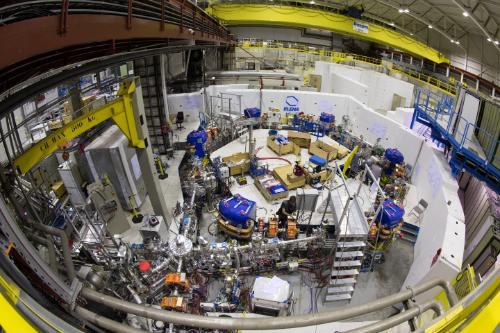ELENA in Wonderland
At the start of Lewis Carrol’s Through the Looking-Glass, young Alice wonders what life would be like in the house at the other side of the mirror, before being magically transported into it.
Almost a century and a half after the publication of the celebrated tale, physicists at CERN have made this crossing through the looking-glass a reality. As a token of the inverted world to be found there, the particle accelerator scientists had to build an antiparticle decelerator.
The so-called Antiproton Decelerator (AD), slows down antiprotons to an energy of 5.3 MeV. In service since 2000, the AD has been helping scientists address fundamental questions like the effect of gravity on antimatter or the imbalance between matter and antimatter in the Universe.
The lowest the energy of the antiprotons the easier it is for the experimenters to manipulate and study them. A new machine called ELENA (Extra Low ENergy Antiproton deceleration ring) has been built to slow the antiprotons down even further, to just 0.1 MeV. In addition, the density of the beams will be improved, increasing the amount of data available for experiments.

ELENA - Image CERN/Maximilien Brice
ELENA measures 30 metres in circumference and has just begun its first tests with beam. After the tests have been finalised, the antiprotons will be sent to experiments were they will be used to produce atoms of antimatter and study its properties.
oPAC fellow Miguel Fernandes has had an important role in the development of the Antiproton Decelerator by designing and building a new type of monitor to measure accurately the extremely low intensities of the antiproton beams (of the order of a few hundreds of nano-Amps).
A precise measurement of the antiproton beam intensity is essential to monitor any losses during the deceleration and cooling phases of the decelerator cycle, and to calibrate the absolute number of antiparticles delivered to the experiments.
In a paper just published in the IOP “Superconducting Science and Technology” journal, Miguel Fernandes and co-authors describe the challenges of implementation and first beam measurements of a Cryogenic Current Comparator (CCC) based on a Superconducting QUantum Interference Device (SQUID). The paper demonstrates the exciting prospects of this new type of beam diagnostics device.
Further information:
CERN Courier, “CERN soups up its antiproton source” Nov 11, 2016
http://cerncourier.com/cws/article/cern/66893
M. Fernandes et al., “Non-perturbative measurement of low-intensity charged particle beams”, Superconductor Science and Technology, Volume 30, Number 1 (2016).
http://iopscience.iop.org/article/10.1088/0953-2048/30/1/015001/meta;jsessionid=26054602281DB37BB97113A5884EE22D.c1.iopscience.cld.iop.org